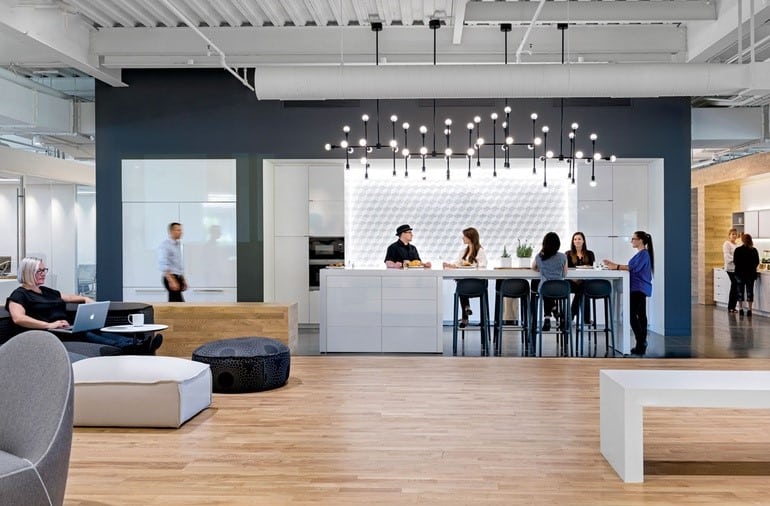
24 Dec 10 Office Design Trends for 2019
10 Office Design Trends for 2019
As the line between work, home, and social life becomes increasingly blurred, it’s this workplace experience and how attractive a proposition it is to come into work every day that will ultimately attract the talent your business craves.
Today’s workplace is all about offering a more holistic experience to staff and office design is now all about designing that experience.
1. The Value Employees’ Wellbeing
As the ‘war for talent’ continues to brew, CEOs’ and their company’s highest priorities are to attract the best talent possible. We’re going to see more organizations realize that they need to invest more in their people. While it’s not always immediately apparent, one of the most cost-effective solutions is creating a healthy work environment. – Work Design Magazine
Engaged employees can boost a company’s bottom line by up to 20 percent.3 These employees are emotionally invested in and focused on creating value for their organizations.
The workplace can engage employees by providing wellness programs, include technology and flexibility in office design and create spaces for effective collaboration.
Experience-Driven Spaces. The goal of which prioritizes the employee experience at work. Experience-Driven Spaces are highlighted by employee-focused and specialized enhancements aimed at developing overall wellness, cultivating happiness, community-building, and boosting morale for everyone from interns to top-floor executives.
These Experience-Driven Spaces include (but are not limited to) features such as:
- Massage therapy and chiropractor consultation spaces
- Meditation areas
- Acupuncture and holistic medicine offerings
- Yoga studios and walking/jogging trails
- Rock climbing walls
- Espresso and cocktail bars
- Game rooms and virtual reality gaming spaces
- Corporate sports tournaments and active spaces (indoors and outdoors)
2. Technology
Technology in the workplace isn’t a new concept. This year, as it continues to drive workplace success and efficiency. Devices are keeping track of where we are and how we are using space. Siri and Alexa, our virtual assistants are becoming more like real assistants. They are listening, answering questions, and are creating our to-do lists, making phone calls, scheduling meetings, and even ordering coffee.
3. Third Spaces
the ‘Third Space’ has long been a debated concept amongst office designers and how these spaces, defined as an area away from the desk and meeting room where staff can work, could best be utilized.
Increasingly companies are looking for space efficiencies so creating these unconventional areas alongside adopting more flexible, agile work practices have risen in both importance and popularity and we feel these unorthodox working and collaborative spaces will become commonplace in new offices during 2018 and beyond.
4. Open Collaborative Space
While a collaborative zone or space isn’t a new phenomenon or office design trend, it is how they are constructed and located within the office landscape that marks them out as different.
5. Walls
Traditionally walled partitions are becoming less popular and alternatively, office designers are now using alternative materials to create dividers to define spaces like nature inspired bamboo walls with shrubbery, metal display cabinets and/or acoustic panels.
6. Textures and Finishes
With the rise of the minimalist office and neutral or streamlined layouts, the texture will become one way for a workplace to introduce a playful side.
Biophilic office design is a broad subject we have witnessed more of (and want to see a lot more of) is a variety of natural finishes and textures being used in office design.
The trend for unusual material combinations – metals, wood, textiles, stone – has been growing and we will see even more of this in 2019.
7. Flexibility
Because the nature of today’s work is so complex and unpredictable, a single, all-purpose workstation doesn’t cut it for most knowledge workers.7 Workspace designers need to provide a variety of “activity settings,” or purpose-built areas for specific activities accessible to all.
Activity settings might include impromptu meeting areas, formal meeting spaces, project rooms, individual workplaces or break areas that make up for the shortcomings of exclusively cellular or open-plan environments. One size does not fit all.
Many offices are now opting for laptops instead of desktops, giving their employees the freedom to work from anywhere. Since work has now become portable, offices need to adjust accordingly. You need power outlets readily available around the office, video conferencing technology, screens for presentations, wireless charging stations, data ports, smartboards, and anything else that is necessary to facilitate smart working.
8. Lighting
Better workplace lighting (both natural daylight and artificial light) has been linked to a 15 percent reduction in absenteeism in office environments. Other studies have reported productivity increases ranging from 2.8 to 20 percent attributed to optimum lighting levels. 10
The presence of ample daylight and windows, as well as opportunities for active and passive contact with nature, sensory change and variability, all have a positive impact on people’s well-being.11
Check out our article on different types of lighting that are best for your office space.
9. Colors
Pantone recently released their eight trend palettes for 2018, and it looks like it has something for everyone, from the young tech start-up to the classic heritage brand or the established professional services firm. (Check out our blog on Color Psychology)
10. Inclusion and Accessibility Improvements
Assistive Technology. Some common assistive technology aids include color-coded keyboards, refreshable Braille displays, specialized screen reader software, assistive listening devices, speech recognition, and sign language apps. Some basic necessities required to make a workplace disabled-friendly.
- Disabled-friendly parking
- Wheelchair accessible doorways
- Ramps at entries and exits of buildings and cafeterias
- Wide corridors and easy access to workstations
- Elevators in all new buildings that have more than one floor
- Accessible operating buttons and/or Braille in Elevators
- Accessible washrooms
- Height adjustable desks
- Accessible plug sockets
- Adjustable monitor arms
What’s next?
Workspace technology, transparency, inclusion, adoption of VR/AR, workplace wellbeing will become even more prominent and workplaces will become inherently more social as home, work and social activities continue to intersect and blur into one.
Sources:
https://k2space.co.uk/knowledge/office-design-trends-watch-2018/
https://workdesign.com/2018/02/2018-workplace-trend-predictions/
https://www.inc.com/aflac/changing-healthcare-for-the-better.html
https://store.steelcase.com/learn/articles/4-emerging-trends-influencing-workplace-design



















